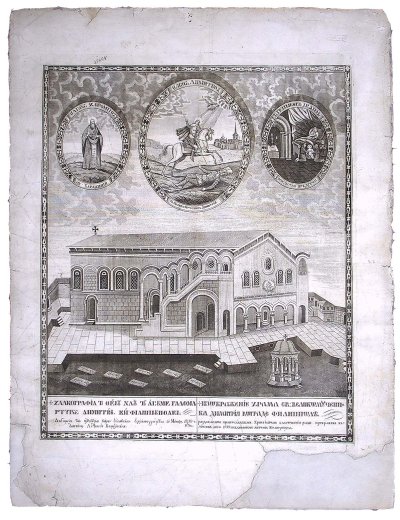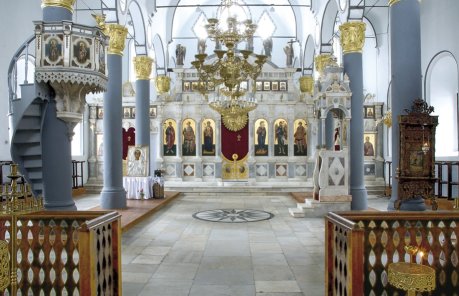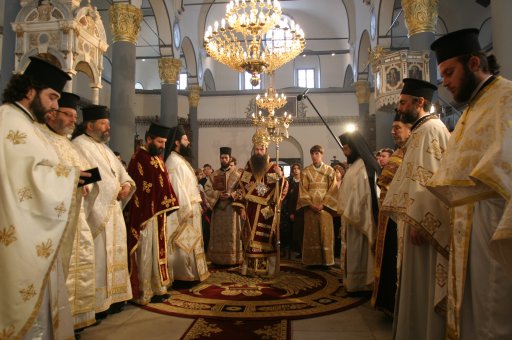Dimitar Atanasov
By ancient Bulgarian tradition, today, the 26th of October is the widely celebrated holiday Dimitrovden – the name day of all men who bear the name Dimitar, and all women who bear the name Dimitrina. For this occasion, we give you an excerpt from Dimitar Atanasov’s book, “The Church ‘St. Martyr Dimitar’ in the Old City of Plovdiv,” exploring the history of one of the oldest historical architectural sights in Bulgaria.
The church “St. Martyr Dimitar” is situated on Djambaz hill, the highest of the three hills in the Old City of Plovdiv. The present building is from 1830-1838. It was built on the place of an old church with the same name, whose foundations were laid in 1230 under the reign of Tsar Ivan Asen II.
During the centuries of Ottoman domination (XIV- XIX) the church was burnt down, flattened and rebuilt many times. The first preserved written record where it is mentioned is “Register of a journey to the Ottoman Gate in Tsarigrad” (1573) by the German theologian professor Stefan Gerlach.
The church is a basilica with a nave and two aisles with the following sizes: 28x19x11.5 m. It was constructed with solid stone walls and a saddle-like roof. The naves are divided with 12 granite columns. Under the balcony there is a spacious narthex, supported from the west side by four marble arcades.
Later the narthex was blocked up. In it, under the slates, lies an ossuary, which is supposed to be from the old church. To the north side of the narthex a belfry is raising, which was built by the project of the famous Plovdiv architect Joseph Schnitter.
In the holy altar there are three thrones- central, dedicated to St. Martyr Dimitar, northern- to St Atanasii the Great, and southern- to St. Haralampii.
The church was sanctified by the Metropolitan bishop of Plovdiv Nikofor Lesbietz on the 18th of January 1838- the day of St. Atanasii the Great.
The iconostasis, the prelatic throne and the ambo are made of white, gray and colored marble. They were made in 1860- 1869 from Odrin stone- cutters as well as local ones from Bratzigovo under the guidance of the painter A. Kalumen. The length of the iconostasis is 14 m., and the pediment over the central throne is 7.5 m.
The marble iconostasis is a unique monument in the Bulgarian national revival art. Proskinitariite ornate with wood-carving are from the old church. The icons with silver repoussee cover from the tsarist row of the iconostasis are also from the old church and date back to the XVI- XVIII century. Art experts suppose that these are works of famous Macedonian masters from Linotipi, Kostur. Nowadays the old icons are replaced by new ones, specially painted for the iconostasis by the Hisarian painter Miroslav Asenov in 2007.
On two of the old icons one can read the name of master Spiro and the years of their painting- “St. Mina” (1814) and “St. Atanasii” (1831). And on two others – “The Birth of St. Joan” (1852) and “St. Nikola” (1858) one can see the signature of the famous at that time icon- painter Nikola from Odrin.
Over the chapiters of the columns are drawn medallions with the images of the twelve disciples. Over the marble back of the prelatic throne is drawn Jesus Christ the Great Archpresbyter (1870). On the five-walled ambo on the marble there are five images: in the centre is Jesus Christ with open gospel-book, and sidelong are the four Evangelists.
On the pediment of the iconostasis, also painted on the marble, is the Last Supper. Over the south gate of the church, under the portico, are painted the images of St Dimitar and St. Haralampii. They all have the same style and painting technique and it is obvious that they are works of the same master created during the same period of time- about 1870.
In the church yard there is a small chapel dedicated to St. St. Kirik and Julita. The highest holy spring in the Old Town is situated in the chapel .Behind it is the church house, where the serving priest lived. In the south-east corner of the church yard there is another church house. A high stone wall surrounds the whole monastery complex, as it was called during the end of the XIX and the beginning of the XX century.
In 1922 Plovdiv bishopric gave the church “St. Dimitar” up to the Russian colony in the town. Till 1964 the church was controlled by the Russian church guardianship.
In the yard there are two graves with Greek inscriptions on the gravestones. It is also there, where archpriest Al. Nedelskii + 1937 was buried.
In 1996 the church “St. Dimitar” is declared as a cultural heritage of local importance.
After years of oblivion, the Association “St. Dimitar”, established in 2004 by 35 namesakes all called Dimitar, from Plovdiv has repaired and restored the monument by donations of its members. The renewed church is sanctified on 26th October 2007 (the day of St. Dimitar), by Nikolai, the Metropolitan bishop of Plovdiv and it is open again for daily liturgy.















1 comment so far ↓
Nobody has commented yet. Be the first!
Comment